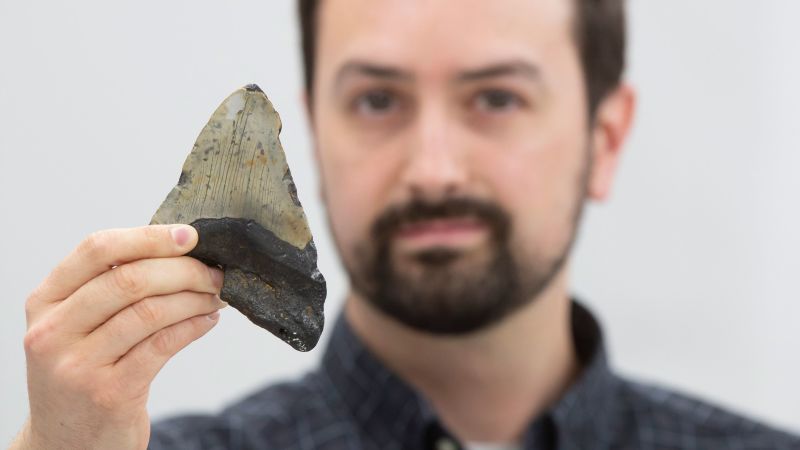
FRANKFURT, Germany – A groundbreaking study has upended the conventional understanding of the megalodon’s feeding habits, suggesting this prehistoric predator was not as selective as previously thought. Instead of exclusively hunting large marine mammals, the megalodon may have been an opportunistic feeder, adapting its diet to available prey to meet its enormous caloric needs.
Immediate Impact
The megalodon, which roamed the oceans until about 3.6 million years ago, was previously believed to prey primarily on large marine mammals like whales. However, a new study published in the journal Earth and Planetary Science Letters reveals that the giant shark’s diet was more varied.
“When available, it would probably have fed on large prey items, but when not available, it was flexible enough to feed also on smaller animals to fulfill its dietary requirements,” said lead study author Jeremy McCormack, a geoscientist at Goethe University in Frankfurt, Germany.
Key Details Emerge
The study’s analysis of minerals in fossilized teeth indicates that megalodon might have consumed a range of prey, including smaller marine animals. This flexibility in diet challenges the idea of the megalodon as a specialized predator.
“They were not concentrating on certain prey types, but they must have fed throughout the food web, on many different species,” McCormack explained.
Zinc in Megalodon Teeth
The research team conducted a geochemical analysis of zinc isotopes in megalodon teeth to deduce the animal’s dietary habits. This method revealed the diversity of the megalodon’s diet, which likely included smaller sharks and other marine life.
“Based on our new results, we see that it was clear it could feed at the very top, but it was flexible enough to feed also on lower levels of the food chain,” McCormack added.
Expert Analysis
The study’s findings suggest that the megalodon shared the top of the food chain with other large predators, including its close relative Otodus chubutensis. This revelation challenges the long-held view of the megalodon as the sole ruler of ancient seas.
Paleobiologist Kenshu Shimada, a coauthor of the study, noted that the dietary overlap between the megalodon and the great white shark could have contributed to the former’s extinction.
“Our new study, that demonstrates the ‘diet overlap’ between the great white shark and megalodon, strengthens the idea that the evolution of the smaller, likely more agile and maneuverable great white shark could have indeed driven megalodon to extinction,” Shimada said.
Background Context
The megalodon, known scientifically as Otodus megalodon, has long fascinated scientists and the public alike. Despite its fearsome reputation, much about the creature remains unknown due to the lack of complete fossilized skeletons, as fish skeletons are primarily composed of cartilage rather than bone.
Previous studies have debated the size and behavior of the megalodon, with estimates suggesting it could grow up to 80 feet (24 meters) in length, far surpassing the size of modern great white sharks.
What Comes Next
Jack Cooper, a UK-based paleobiologist and megalodon expert, emphasized that the study adds a new dimension to our understanding of the ancient predator.
“The general picture of megalodon has been of a gigantic shark munching on whales,” Cooper said. “This study adds a new dimension that megalodon probably had a wide range of prey — essentially, it probably ate not just whales but whatever it wanted.”
As research continues, scientists hope to uncover more about the megalodon’s ecological role and how it compares to modern apex predators. The study’s findings highlight the adaptability of the megalodon and its ability to thrive in diverse marine environments.
Alberto Collareta, a researcher at Italy’s University of Pisa, noted that the study reshapes the traditional view of megatooth sharks and underscores the complexity of ancient marine ecosystems.
“These have led us to abandon traditional reconstruction of the megatooth sharks as ‘inflated’ versions of the modern white shark. We now know that the Megalodon was something else — in terms of size, shape and ancestry, and of biology, too,” Collareta said.
This new understanding of the megalodon’s diet and ecological role may pave the way for further discoveries about the ancient oceans and their inhabitants.







